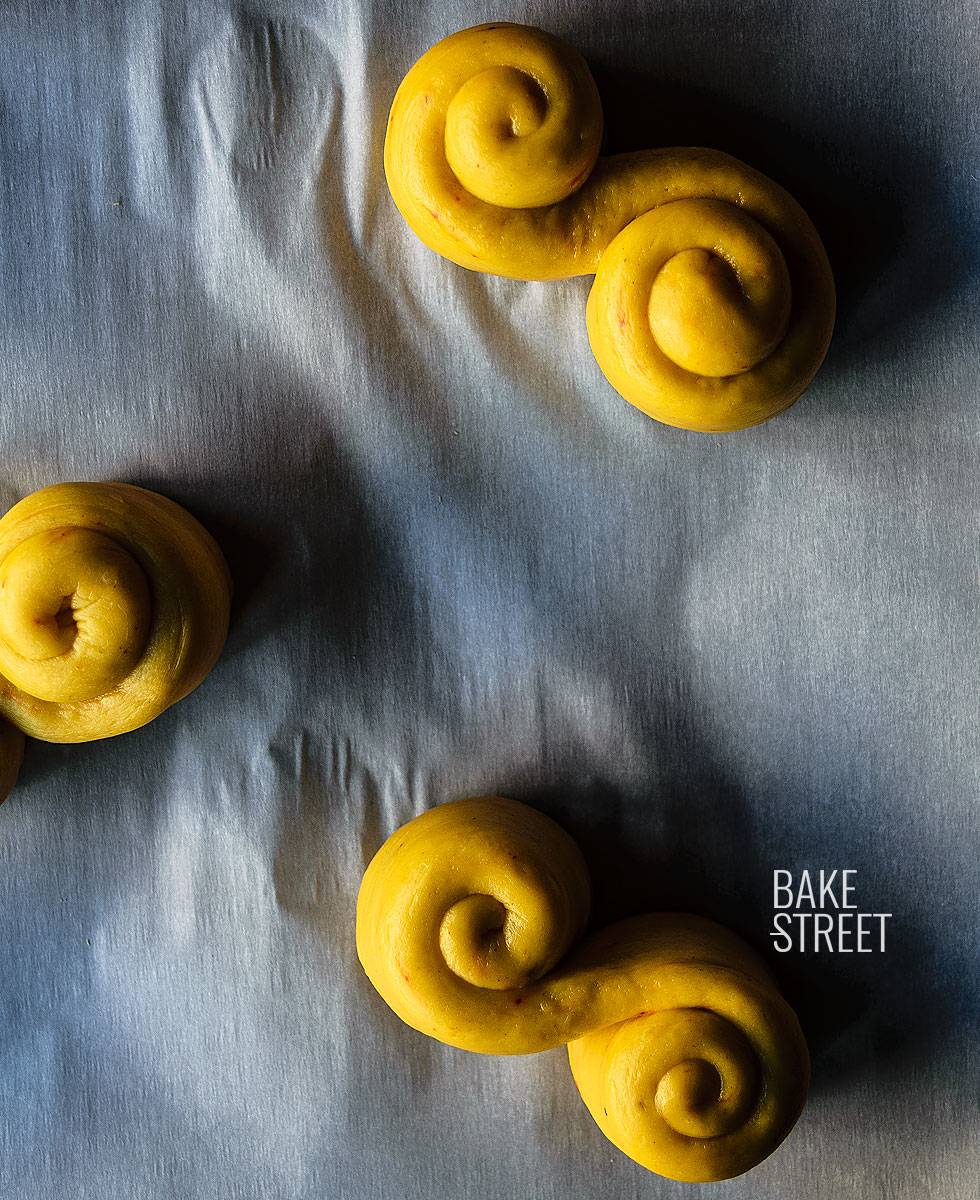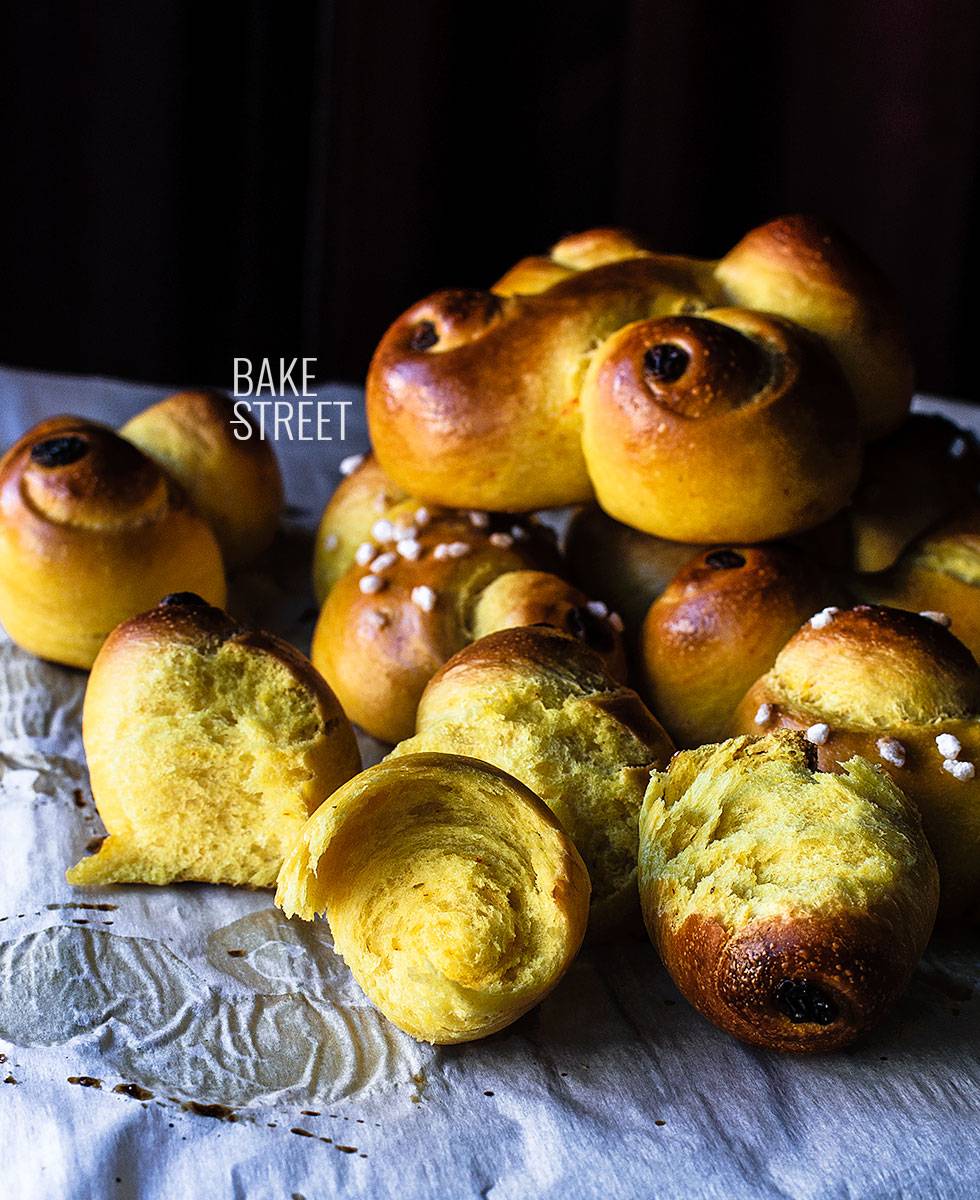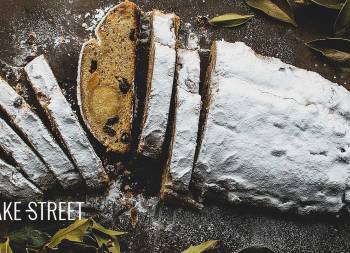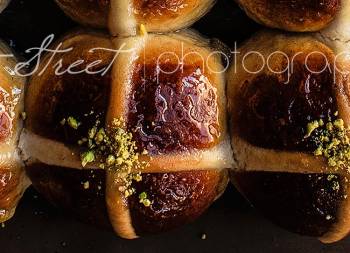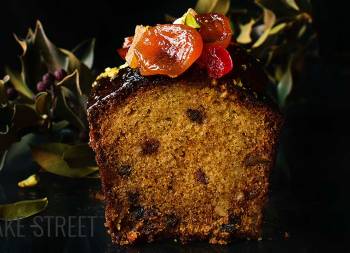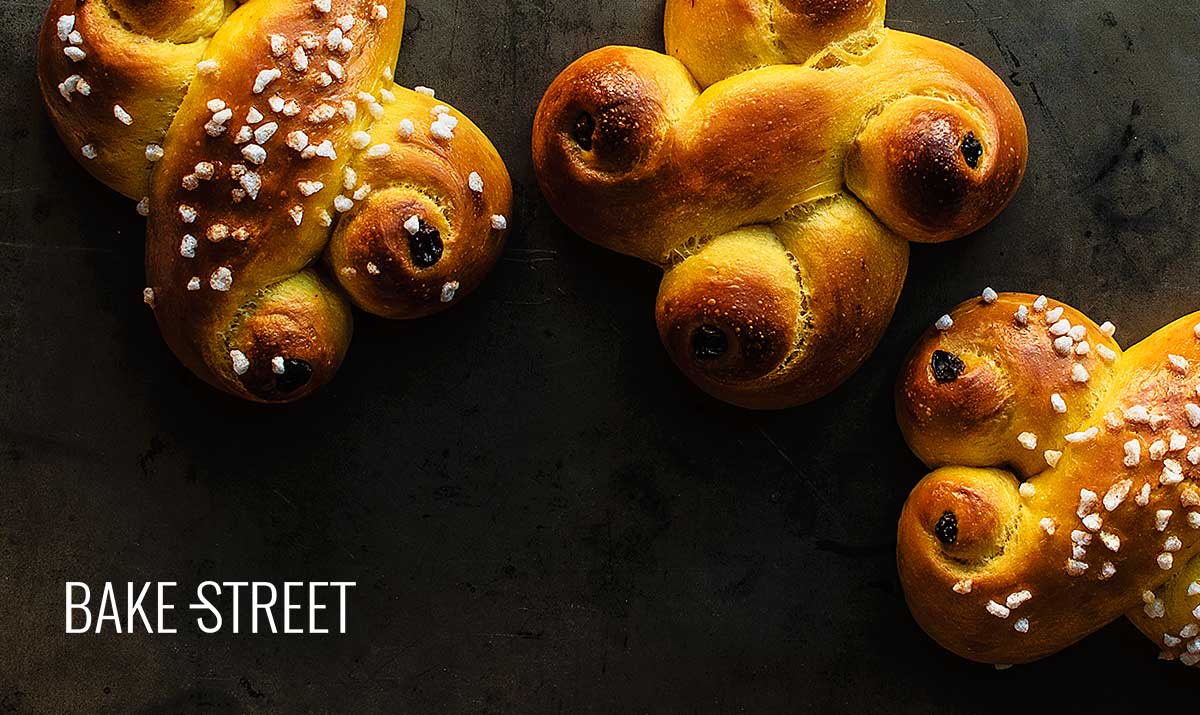
Lussekatter, St. Lucia buns
Today, as it could not be otherwise, I bring you a new Christmas recipe (Christmas recipe? uy that’s weird, right?). Well, we’re on dates and this season has so many “enjoy” things that the less we miss, the better. To see today´s elaboration we will go to the Scandinavian countries, specifically to Sweden, from where these Lussekatter or St. Lucia buns are typical.
Saffransbullar or saffron buns are Swedish sweets that are traditionally eaten until Christmas. December 13, St. Lucia’s Day (Luciadagen), an important festival in Sweden.
These buns receive many names for which we are sure to recognize some of them:
- Lussebulle
- St. Lucia buns
- Julkuse
- Or as they used to call them Dövelskatt o Dyvelkatt, (Dovel originally meant devil)
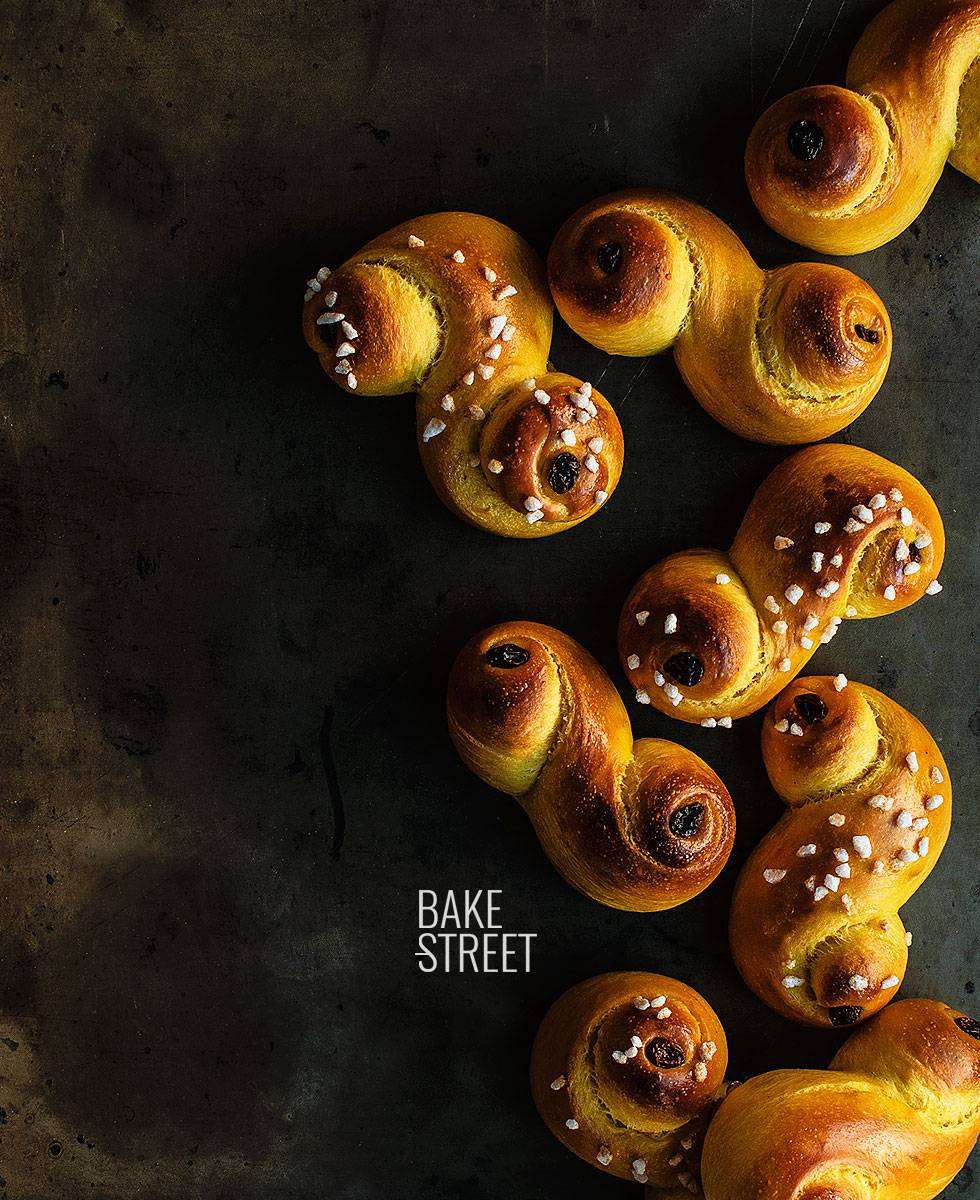
Origin of the Lussekatter.
The story tells an interpretation in which it shares that the tradition of consumption of these saffron buns was born in 1600 in Germany.
According to legend, it is said that the devil looked like a cat and used to move among the children in order to do evil among them. Jesus, who looked like a child, distributed these golden coloured buns among those who were good and thus managed to protect them and keep evil from them.
The buns were flavored with saffron because their color was reminiscent of sunlight, a condition that would keep evil and darkness away. It is believed that there is a nexus between the name Lucia and Lucifer because of their phonetic similarity.
How to make St. Lucia buns.
There are many ways of shaping them, the most common is julgalten, the most traditional and recognizable by all of us in the shape of –S. Another very common way are two -S crossed as a cross, they are called lana wagon, julvagn o julkors. The most common shapes originated from the pattern of jewelry and photographs of northern Europe dating back to the Bronze Age. Other forms we can find are Pojke, Gullvagn, Lilja.
Before baking, they are brushed with beaten egg and usually decorated with raisins, although we can also find cherries or dried cranberries, pearl sugar and almonds.
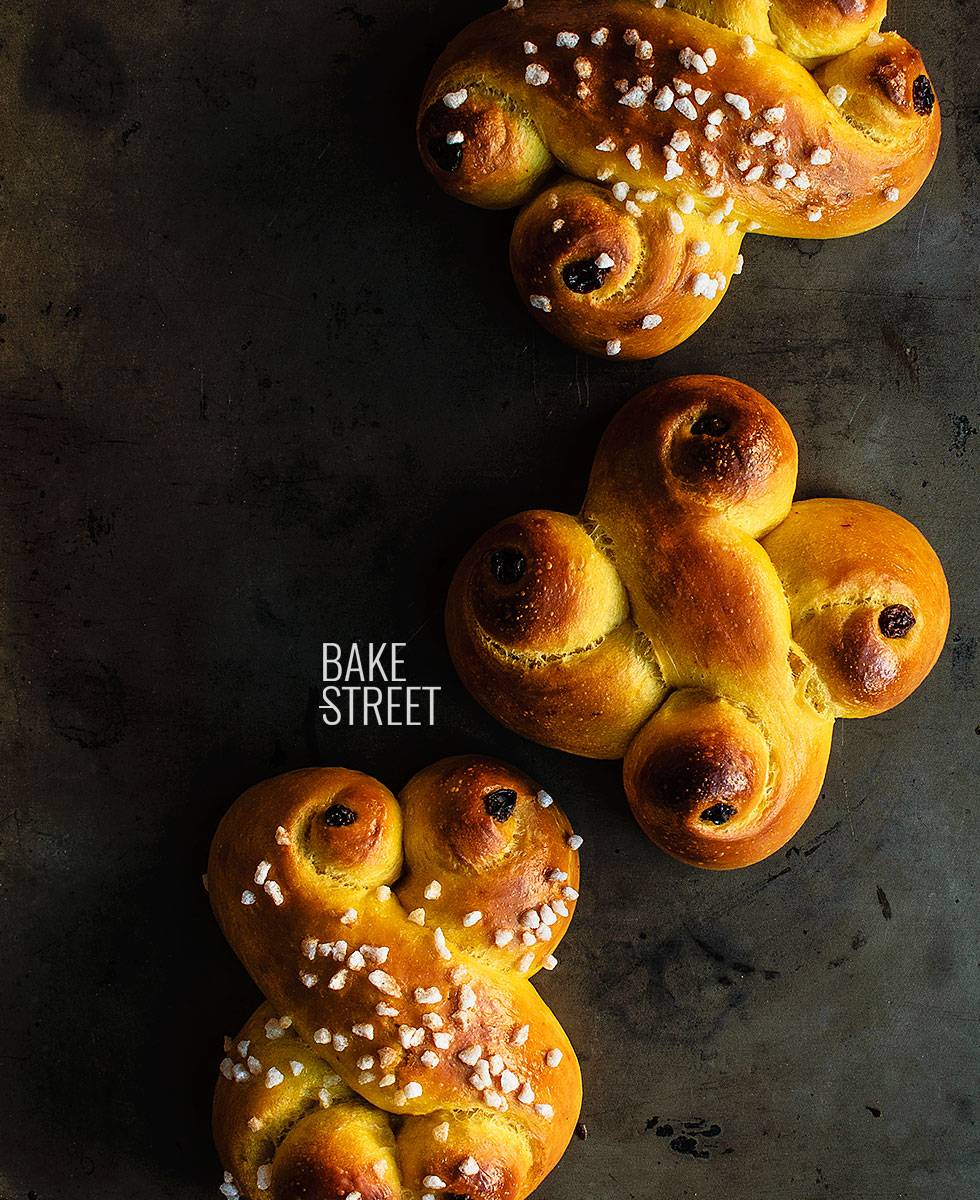
Saffron, a valuable spice.
Not everyone could enjoy these golden buns. Saffron is one of the most expensive spices and only powerful people could afford it. The provinces surrounding Lake Mälaren in Östergötland and Gotland consumed most of them by the late 1600s. From 1800 onwards, the consumption of these buns began to expand throughout the country.
Today most of the buns we find available on the market are made with food colorants that provide that characteristic shade because the use of such amounts of saffron in sweets would be very expensive. At the end of World War I, when the shortage of saffron forced bakers to find alternatives to this ingredient, other colorants were already used for this type of elaboration.
The figure of St. Lucia plays an important role in Sweden.
St. Lucia was the light-bearer in the dark winters giving way to the spirit of Christmas. Born in Syracuse, Sicily, in the year 283 and died in the year 304 AD.
The way in which this Saint came to Sweden and part of Finland is unknown, as well as the way in which they appropriated this tradition. In the Middle Ages it was celebrated beginning the season of the Advent season, and Stockholm began to follow this tradition formally.
Saint Lucia, educated in the Christian faith, consecrated her life to God and made a vow of virginity. Her sick mother committed her to a young heathen and she persuaded her to get rid of that commitment. He asked her to pray at the tomb of “Águeda de Catania” to cure her illness. The mother healed and Lucia asked her to free her from the commitment.

Her suitor accused her of being a Christian in the time of Emperor Diocletian and ordered her to be sacrificed to the gods. She was accused of witchcraft after several tortures and when she escaped from them unharmed, she was accused of witchcraft and therefore condemned to die at the bonfire. It is said that she survived the fire and her eyes were damaged, although she still saw. She was finally executed.
According to tradition, her story was divulged throughout Sicily, consecrating her virginity to martyrdom.
She is the patron saint of the view because of the legend that when Lucia was in court, without eyes, she kept seeing. She is also the patron saint of the poor, the blind, the sick and certain cities of Syracuse, Venice and Peter of the Mount.
Since her death coincided with the winter solstice and the name of the Saint means “the one who carries light”, it would explain the later legend about her eyes.
The reality between Lucia and the Swedish tradition.
In spite of what is believed, the celebration of St. Lucia’s Day will be celebrated in Sweden on 13th December, has nothing to do with her. The only thing they have in common is the name.
December 13th has an error in the Julian calendar, 365,25 days. At first it seems a little bit out of phase, but 128 years later that error became 1 full day and until 1300 the error was out of phase for almost 2 weeks.
Originally the winter solstice was on December 25th, hence the Christmas celebration that day, but in the Middle Ages it was around December 13th. So, that was the longest night of the year at the time. A calendar dating back to 1702 specified on December 13:” The longest night when the cold winter begins“.
It was believed that during that night evil was present all night long. That’s why, according to Folktron (popular beliefs), it is believed that it was dangerous and people stayed awake. In Germany there was a tradition of dressing a girl in “Christkindlein“, the child Jesus, who represented glory. This tradition came to Sweden, but instead of a girl it was a woman dressed in white with candles in her hair.
Tradition.
St. Lucia’s gesture conveys to the children of each house the opportunity to care for and asist for others. Parents tell their children how Lucia took care of orphans, pilgrims and widows, showing them that they should take care of all those who are sick or lonely. In fact, Swedish schools organize trips with the children to visit hospitals, orphanages and old people’s homes during those days.
The tradition is that the eldest daughter of each household wakes up singing to her family and accompanies them to the well-stocked breakfast table, wearing a candlelight crown marking the beginning of Christmas.
Today, children also have the same opportunity to participate in this celebration by serving breakfast to their parents, a good cup of coffee accompanied by ginger biscuits and saffron buns.
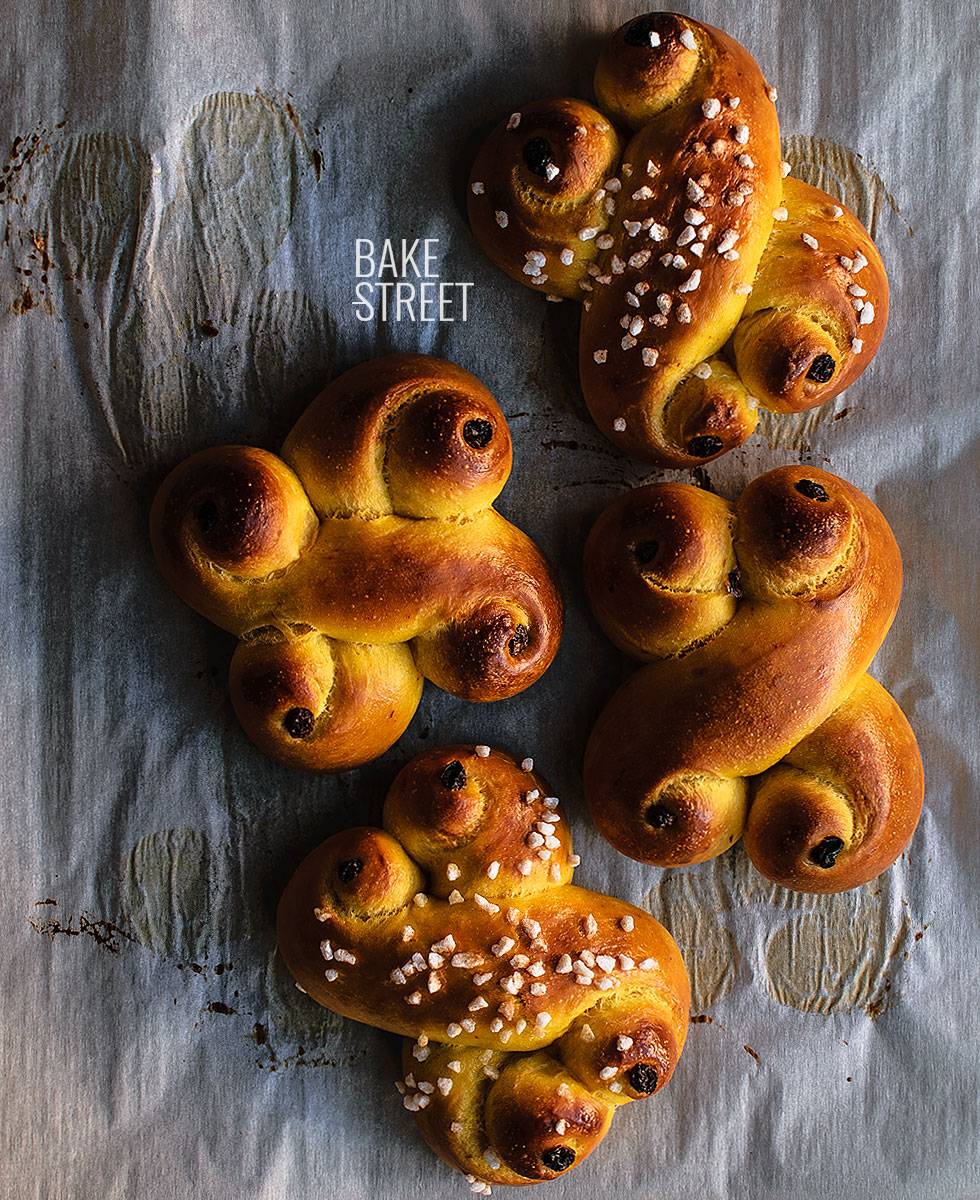
On this day, the young Swedes participate and celebrate “Lucia’s procession” (Luciatåg).
In this procession a girl represents Lucia and wears an attire consisting of a white tunic, red sash and a wreath of wire covered with blueberry leaves and 7 lit candles. It is accompanied by other maidens dressed in white with candles and the children are known for dressing as Magicians or Stars or even “gingerbread men” (pepparkaksgubbar) or Tomte (Scandinavian goblins, Swedish/Norwegian version of Santa Claus).
These buns are present in Swedish households during these days along with gingerbread, and are usually accompanied by some coffee or Gløgg (spiced wine).
The feast of Luciadagen involves many traditions.
Some of them are very old, in which they say that this day sets the moment when it is not possible to shear, spin or weave, since Christmas presents must already be prepared. The cookies to be taken during the holidays should be ready and the candles that will decorate the tables should be stored somewhere special.
Some of them consume lutfisk, a traditional Christmas fish made from dried white fish and caustic soda, claiming that to be in its exact point it should be buried in beech ashes the day before Saint Lucia. The latter tradition may be due to the fact that birch ash is used instead of soda in Finland, making the treatment less aggressive.
According to their tradition, Christmas does not begin until everyone eats saffransbullar and pepparkakor.

Our elaboration.
If there’s one thing I like to do is get to know the traditions of different parts of the world. On this occasion we will open the doors to St. Lucia buns, Lussekatt or Lussekatter (in plural), which means “cats of Lucia“. It is customary to accompany them with Gløgg, hot spicy wine, which if you have not tasted it, I recommend you to do so.
These are the three shapes that we will carry out:
- Julgalten, the most traditional. The ends are rolled up simulating an -S and in the center of each spiral is placed a raisin.
- Julkors, Christmas cross. Two julgalten are shaped and joined together in the centre to form a cross. The spirals at each end are “looked at each other”.
- Gullvagn, Christmas cross. Two julgalten are shaped and joined together in the centre to form a cross. Spirals don’t look at each other.
Ingredients for 12-16 pieces
- FOR THE DOUGH:
- 22,2 oz (630 g) bread flour
- 10,5 oz (300 g) whole milk
- 2 large eggs
- 4,25 oz (120 g) sugar
- 3,5 oz (100 g) unsalted butter at room temperature
- 0,17 oz (5 g) dry yeast
- 0,025 oz (0,7 g) saffron (I recommend using half powder and half in strands)
- 12 cardamom seeds
- 0,25 oz (7 g) salt
FOR DECORATE:
- 1 large egg for brush + 1/2 Tbsp whole milk +pinch of salt
- 32 raisins
- pearled sugar
Instructions
FIRST DAY
Make lussekatter dough.
- In a mortar, add the cardamom pods and mash. Remove the shells.
- Incorporate the saffron strands and grind together with the cardamom. In this way we moisten the seeds and reduce the strands to small pieces. Set aside.
- In a large bowl add the flour together with the reserved spices, the saffron powder and part of the milk. Mix.
- Dilute dry yeast in the small amount of milk we have reserved. Set aside.
- Stir in the eggs one by one, mix them with a scraper.
- Start mixing the butter and sugar. We will do it little by little and alternating both ingredients.
- Add a small amount of butter, mix with both hands to amalgamate the ingredients. We integrate a little sugar and carry out the same process. Repeat until the ingredients are completely integrated.
- Add salt and mix again.
- Finally, add the yeast diluted in milk and mix again until a more or less homogeneous dough is obtained.
- Dump the dough on a clean surface and knead until a fully developed gluten is obtained. It will take a few minutes... Ideally, you should combine kneading and rest to facilitate the process. Do not forget to cover the dough always at rest to prevent it from drying out.
Make bulk fermentation.
- Once we have the dough with a perfectly developed gluten, make a ball with care.
- Grease a tupper or hermetic container, introduce the dough inside and let it rise until almost grows 1/3 of its volume. In my case it was 3 hours at 70ºF.
- Store in the refrigerator until the next day.
SECOND DAY
Shape St. Lucia buns.
- Warmd the dough before working with it, in my case it took 2 1/2 hours.
- Line 2 baking trays with baking paper, set aside.
- Dump the dough on a clean surface and degas gently by pressing with your fingertips.
- Divide into 16 portions as similar as possible, should weigh about 2,65 oz (75 g).
- Shape strands approximately 12-14 inches (30-35 cm) long.
- Flatten gently with your hand along the entire length of the strand.
- Roll up on itself until the middle of it, turn the strand and roll from the other end towards the center.
- In the case of making them double we will shape the buns in the same way as the previous ones but leaving an unrolled space in the center so that we can join them together in a cross. Cover with film and let rise until double in size. In my case were 3 hours at 70ºF.

Bake.
- Preheat oven to 390ºF.
- Brush with beaten egg, decorate with raisins and pearl sugar (if desired) and place in the oven at medium height. Bake for 15 minutes, they should take a light golden color. Remember that the internal temperature must reach 190-195ºF for cooking to be complete.
- Remove from the oven and let cool completely over a rack.

Notes
- Why do you recommend using half saffron in strands and half powder? Mainly by mania, but the reason for doing it this way is because the dough will get a brighter and more vivid color. Besides appreciating small pieces of saffron in strands... I had already warned you, my crazy things! Of course you can use everything in powder or all in strands if you want. The taste will be outstanding anyway.
- Can I use ground cardamom instead of seeds? Of course you do. The exact proportion I wouldn't know how to say, I guess with a little less than 1/2 teaspoon will do us good.
- You do the process in two days, can I do it on the same day? Yeah, sure. The reason for doing it in this way, besides improving its final taste, is to facilitate the elaboration process and not spend many hours in a single day. In cold weather, the proofing times are very long.

- These buns don't preshape. Once they have made bulk fermentation, degas them with your hands and cut them trying to create a strip shape. The reason is that if we touch the dough excessively, the external result will not be smooth. We'll get cracks.
- The buns grow quite a lot in the oven so you should leave space between them to prevent them from coming together during baking. If you shape single units, fit 8 units per tray and if you make them double 4 units.
- Preservation, we can store them in an airtight container or zip bag for 2-3 days.

The truth is, what a long story I've told you today... Oh my God! If you have managed to get here without skipping a line I give you my sincere congratulations, hahaha. When I get to write, I'm a danger.
It's a good thing that to compensate we have these wonderful St. Lucia buns. Enjoy a hot chocolate, coffee, infusion or Gløgg. In any case, I wish you a wonderful weekend. See you Monday: D
Big hugs,
Eva
Sources:
- The recipe and the information are part of one of my online workshops, Doughs and Scandinavian pastries, although I have modified some points. Some of the information I got from the Luzia Light website, which is currently a website that no longer exists.
- Wikipedia
- Book "Nordisk familjebok", info through Faktoider.
- Hogtider
